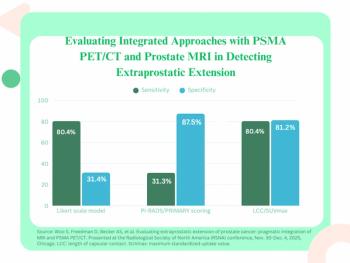When the prostate-specific antigen (PSA) density was less than 0.15 ng/mL2, researchers noted a greater than 50 percent false positive rate in patients with zero or one PI-RADS 3-5 lesion, according to a new prostate magnetic resonance imaging (MRI) study involving over 2,500 patients.
For the retrospective study, recently published in Radiology: Imaging Cancer, researchers reviewed prostate multiparametric MRI (mpMRI) data from 2,548 men (mean age of 65.7) who had zero or one PI-RADS 3-5 lesion. False-positive (FP) results occurred in 831 cases (52 percent) and 150 patients (15.8 percent) had false-negative (FN) results, according to the study.
The researchers found that men with low PSA density were significantly less likely (a 55 percent odds ratio (OR) per 0.1 ng/mL2 increase in PSA density) to have FP results, Conversely, high PSA density was significantly associated with FN results with study authors noting a 2.05 OR per 0.1 ng/mL2 increase in PSA density. For patients with a PSA density > 0.45 ng/mL2, the researchers said the FN rate was approximately 60 percent.
“PSA density was the dominant predictor of FP and FN results and should be a major consideration when interpreting results of mpMRI (i.e, whether to biopsy an equivocal finding, or whether to re-biopsy if the first biopsy finding is negative),” wrote lead study author Bassel Salka, M.D., who is affiliated with the Department of Urology with the Henry Ford Health System in Detroit, and colleagues.
The study authors also noted that younger age, smaller lesions, and transition zone lesions were associated with a greater likelihood of FP results. In particular, transition zone lesions were 74 percent more likely than peripheral zone lesions to lead to FP interpretation of mpMRI, according to the researchers.
In addition to high PSA density, the study authors noted older age was independently associated with FN results with an OR of 1.03/y.
Three Key Takeaways
- PSA density as a key predictor. PSA density was the dominant predictor of both false-positive (FP) and false-negative (FN) results in prostate multiparametric MRI (mpMRI). A PSA density below 0.15 ng/mL² was associated with a greater than 50 percent false-positive rate, whereas a PSA density above 0.45 ng/mL² was linked to an approximately 60 percent false-negative rate.
- Limitations of PI-RADS alone. The current PI-RADS v2 algorithm does not incorporate PSA density or patient age, which were found to improve diagnostic accuracy. Combining these factors with PI-RADS improved the area under the receiver operating characteristic curve (AUC) from 76 percent to 82 percent for diagnosing PI-RADS 2 and higher prostate cancer.
- Clinical implications for biopsy decision-making. The study suggests that PSA density should be a major consideration when interpreting mpMRI results, particularly in deciding whether to biopsy an equivocal finding (e.g., PI-RADS 3) or to re-biopsy after a negative initial biopsy. Additionally, transition zone lesions and younger age were associated with a higher likelihood of false-positive results.
The researchers pointed out that neither PSA density nor age are included in the current PI-RADS v2 algorithm. However, the study authors found that combining age and PSA density with the PI-RADS algorithm had a higher area under the receiver operating characteristic curve (AUC) (82 percent) for diagnosing PI-RADS 2 and higher PCa in contrast to 76 percent for the PI-RADS system alone.
“Use of PSA density in combination with PI-RADS v2 can improve diagnostic accuracy and, importantly, could help mitigate the large fraction of FP results for PI-RADS 3 observations,” noted Salka and colleagues.
(Editor’s note: For related content, see “Can MRI-Based Deep Learning Improve Risk Stratification in PI-RADS 3 Cases?,” “Is PI-RADS Version 2.1 Outdated for Prostate MRI?” and “Can MRI-Based AI Bolster Biopsy Decision-Making in PI-RADS 3 Cases?”)
Beyond the inherent limitations of a single-center retrospective study, the authors acknowledged that the cohort was limited to those who had zero or one PI-RADS 3-5 MRI findings. Noting that patients with false-negative prostate MRI exams had a biopsy despite negative MRI results, the study authors suggested that this group was likely enriched with higher-risk features.




























